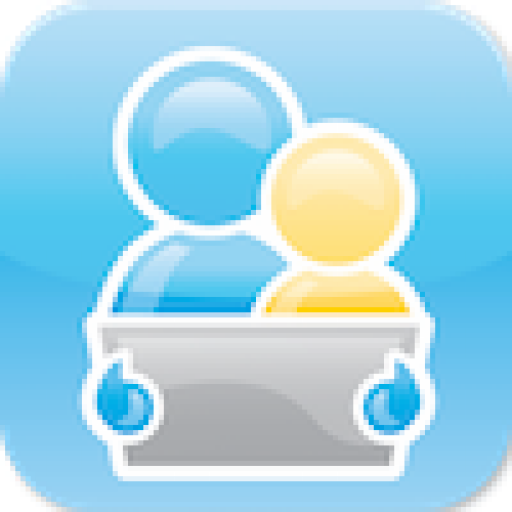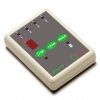In the beginning, there was no switch access to the iPad/iPhone/iPod touch. Over time, however, a small range of apps have been released which offer internal switch access – but unfortunately different apps were released along with different switch interfaces and a confusing picture of switch access to the iPad began to appear. (For more information on this topic read “How do I use a switch with an iPad“)
Luckily for us, the APPlicator from Pretorian changes all that!
The APPlicator is a very easy to setup interface. I simply pulled it out of the box, charged it (rechargable via USB cable) and then turned it on by pressing any of the buttons on the front. My iPad saw it almost immediately and I simply had to select it to connect – no need to enter a string of numbers to make the connection work. Once I was connected, I just needed to plug up to four switches into the switch ports on the interface and I was ready to go. (And as a security measure, once the APPlicator is connected to one iPad, it isn’t available to any others until it has been reset).
One of the very exciting features of the APPlicator is that it can be configured to send up to 22 different commands/keystrokes to your iPad. However – I think one of the best features is that the default settings provide access to the four most commonly used keystrokes within switch accessible iPad apps. Switch port 1 is setup to send “space” – which allows me to access any app programmed for the Blue2. Switch port 2 is setup to send “enter” which is also used as the switch 2 keystroke for Blue2 compatible apps. Switch port 3 is setup to send ~1 – which then allows me to access any app programmed for the RJ Cooper/Therapy Box switch interfaces. And switch port 4 sends ~3 which is the switch 2 keystroke for the same group of apps. To control different apps, the easiest option therefore is just to move the switch or switches into different ports rather than changing the functions the ports are set to.
However, if I want more control of what the switch ports do, I can select any of the four switch ports and change which keystroke it sends – options include up and down arrows, left and right arrows and music controls. While these aren’t needed for any of the current switch accessible apps, this may give you access to some eBook readers or music apps and certainly gives you a wider range of options for compatibility with future apps.
On top of this high level of switch app compatibility, the APPlicator also offers some great control over the music on your iPad/iPhone/iPod touch. The four switch interfaces can be set to control music functions such as play/pause, next track, previous track, volume up, volume down and mute. The interface can be setup with the most important function set for each switch port – or for a user with a single switch port 1 could just be set to play and pause music so the user can work their way through a playlist.
Another option for playing music is the timed play mode. Switch ports can be setup to play a song for either 10 seconds or 30 seconds – enabling an iPad to be used for practicing switch presses in the same way we used to do it with a PowerLink and a cassette deck.
In addition, there is a clever QuickMedia mode which allows you to quickly move between controlling apps and controlling music. Most switch users will not be able to do this independently – but by pressing the QuickMedia button on the front of the interface, the switch ports automatically move into music control mode. Switch port 1 allows you to play/pause music, switch port 2 moves to the next track, switch port 3 moves to the previous track and switch port 4 offers 10 second timed music play. Once the user has launched some music, another press of the QuickMedia button returns the interface to the normal app control functions. This clever feature gives support staff the option of changing a user quickly between music mode and switch app scanning mode without changing any of the switch port functions.
Overall I am very impressed with the APPlicator. If you are making the decision of “which switch interface do I get” this is the current obvious choice as it is the only interface compatible with all the existing switch accessible apps – and on top of that offers control over the iPad/iPhone/iPod touch music functions which none of the pre-existing switch interfaces offer. Even with the upcoming more comprehensive switch interface options, such as the Tecla Shield, I think this interface is worth considering for many developing switch and scanning users due to the ease of setup and use and the wide range of compatibility and functions on offer.
PS – Testing this interface prompted a fairly large update to our Switch Accessible Apps list. This now has an extra column showing the keystrokes each different app require, so that those using the APPlicator can set their switch ports to the right option. The list is available from here. (edited to add – this list has been discontinued)



Pingback: Accessible iPad Apps - RebeccaBallard.com
Pingback: How do I use a Switch with an iPad? – June 2012 update! | Jane's Blog
Pingback: SimplyWorks for iPad Part 2: Joystick and Keyboard Access | Jane's Blog
Pingback: How do I use a Switch or Joystick with an iPad? – October 2012 update! | Jane's Blog
Pingback: How do I use a Switch with an iPad? – June 2012 update! | Jane Farrall's Blog
Pingback: How do I use a switch with an iPad? iOS 7 Overview | Jane Farrall's Blog
Steve
Jane
Pingback: How do I use a Switch or Joystick with an iPad? – October 2012 update! | Jane Farrall Consulting
Amy
jane
Craig Tucker
jane
Lynne Wilson
jane